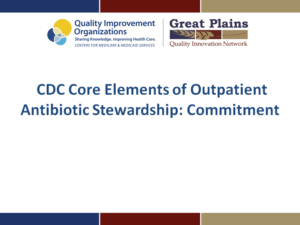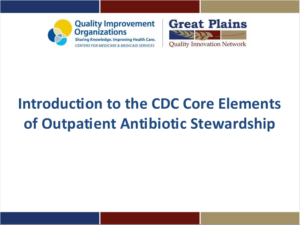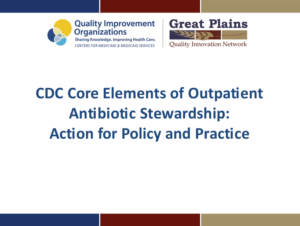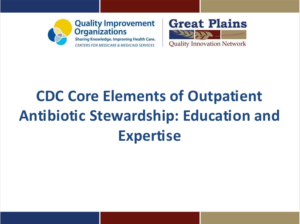Antibiotic Stewardship
Coordinated interventions designed to improve and measure the appropriate use of antimicrobials
Antibiotic Resistance: A Serious National and Global Health Problem
The discovery of antibiotics in the early 20th century fundamentally transformed human and veterinary medicine. Antibiotics now save millions of lives each year in the United States and around the world. However, the rise of antibiotic-resistant bacterial strains represents a serious threat to public health and the economy. The CDC estimates that annually at least two million illnesses and 23,000 deaths are caused by antibiotic-resistant bacteria in the United States alone.¹
As more strains of bacteria become resistant to an ever-larger number of antibiotics, our drug choices will become increasingly limited and expensive and, in some cases, non-existent. If this trend continues unchecked, a wide range of modern medical procedures, from basic dental care to organ transplants, likely would be accompanied by a much greater risk of developing a difficult-to-treat or untreatable antibiotic infection. The safety of many modern medical procedures is dependent on the ability to treat bacterial infections that can arise as post-treatment complications.²
“Every day we don’t act to better protect antibiotics, we will make it harder and more expensive to address drug resistance in the future. Drug resistance can undermine both our ability to fight infectious diseases and much of modern medicine.”
– Dr. Tom Frieden, MD, MPH, Director U.S. Centers for Disease Control and Prevention
1. Centers for Disease Control and Prevention
2. White House National Strategy for Combating Antibiotic Resistant Bacteria
Antibiotic Stewardship News
News
Improving Patient Safety | Healthcare-Associated Infection Prevention Resources in North and South Dakota
A Call to Action in Long Term Care & Adult Care Facilities: Caring for People with Substance Use Disorder | GNYHCFA Webinar Series
National Prescription Drug Take Back Day – October 26, 2024
Raising Awareness: Say Sepsis. Save Lives.
CDC Outpatient Core Element Video Series
The Great Plains QIN has developed the following video series as a framework for providers to identify and select key actions for implementation from each of the CDC Core Elements of Outpatient Antibiotic Stewardship.
Introduction to the CDC Core Elements of Outpatient Antibiotic Stewardship
Runtime: 16 Minutes
This introductory video presents the CDC Core Elements of Outpatient Antibiotic Stewardship, providing a framework for providers to identify and select key actions for implementation. Through increased awareness, you will learn the benefits of antibiotic stewardship and why this is important to your community.

CDC Core Elements of Outpatient Antibiotic Stewardship: Commitment
Runtime: 12 Minutes
This video provides an overview of commitment, outlining the importance of dedication and accountability for optimizing antibiotic prescribing and patient safety. Any person involved in patient care can act as an antibiotic steward for the health of your patients and the community in which you serve.
CDC Core Elements of Outpatient Antibiotic Stewardship: Action for Policy and Practice
Runtime: 18 Minutes
This video delivers the implementation of policies and interventions to promote appropriate antibiotic prescribing practices. Action is necessary to transform policy and practice into measurable outcomes. Effective communication, documented justification and support for clinical decisions are key practices endorsed by the CDC.
CDC Core Elements of Outpatient Antibiotic Stewardship: Tracking and Reporting
Runtime: 12 Minutes
This video offers several alternatives to improve tracking and reporting of antibiotic prescribing. Examples of measures and outcomes to be tracked will be identified and opportunities for improvement or percentage of all visits led to antibiotic prescriptions are discussed.
CDC Core Elements of Outpatient Antibiotic Stewardship: Education and Expertise
Runtime: 15 Minutes
This video provides valuable educational resources and health literacy for clinicians, patients and caregivers to improve appropriate antibiotic use and potential adverse drug events. Education to each person involved in patient care can help improve the overall quality of care. A number of resources can be found online from the CDC.
Training Events
[ai1ec view=”stream” tag_name=”Antibiotic Stewardship” exact_date=’7-1-2014′]
Documents & Resources
External Resources
Nursing Home External Resources
|
Title
|
Source
|
|---|---|
| Agency for Healthcare Research and Quality | AHRQ.GOV |
| Antibiotic Stewardship Resources for Long-Term Care | GREATPLAINSQIN.ORG |
| LTC Requirements of Participation Infection Control Components Checklist | GREATPLAINSQIN.ORG |
| Nebraska Medicine | NEBRASKAMEDICINE.COM |
| North Carolina Statewide Program for Infection Control and Epidemiology | UNC.EDU |
| Minnesota AS toolkit and resources | HEALTH.STATE.MN.US |
| The PEW Trust: Antibiotic Stewardship in Long-Term Care Facilities | PEWTRUSTS.ORG |
Meet the Experts
Great Plains Quality Care Coalition
Our Vision: Through collaboration and partnership, we aspire to make healthcare in the Dakotas the best in the nation. We have partnered with committed nursing homes, community leaders and healthcare organizations to improve the care in our communities. Better together.






